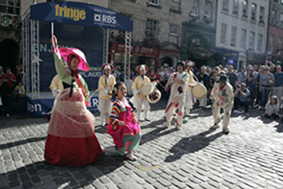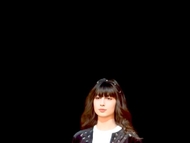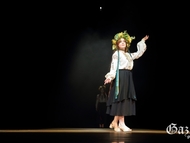
A Keimyung University student team held a gakseoli performance titled Beggar’s Love at the Edinburgh Fringe Festival, a world famous festival, last summer. Gakseoli is an old Korean beggar song and dance for food. The performance of the ten members was the first case of a Korean university student team joining the festival. The BBC showed their performance, and they were invited to perform at the opening of a theater festival in Spain in May. The Gazette met the director, Go Soon-chul, who majors in advertising and public relations at Keimyung University.

1. Would you introduce Beggar’s Love?
It is a non-verbal gakseoli performance combined with Korea traditional folk music, samulnori, and B-boy dance. It’s about a beggar’s love, and various characters appear: a drunkard, a maimed person, a two-faced person, a crazy woman, and a beautiful woman.
2. When did you begin to be interested in acting?
I began to be interested in performance through the dancing club at Keimyung University, and I participated in the University Student Hip-Hop Festival at Daegu Migliore in 2001 and 2002. After military service, I worked at an event planning company for one year. I participated in producing Jekyll and Hyde at the 2007 Daegu International Musical Festival, and it won second prize.
3. Did you have a special motive for performing Beggar’s Love?
In 2006, I traveled to many festivals in Europe for forty days. I lived like a beggar with very little money, and I thought it could be good to perform gakseoli, which is an old Korean beggar song and dance for food. I happened to see a Korean samulnori performance there. At first, many passers-by looked curiously at the show, but they didn’t watch it for a long time. An idea hit upon me that the show could be more interesting if it was combined with young popular B-boy dancing.
4. How did you organize the gakseoli performance team?
I prepared from September 2006, but the members changed, so I gathered new members who were majoring in ballet, B-boy dancers, and samulnori players. At first, the team members didn’t know each other without me. However, all the team members got together to achieve their dream, and that dream made them cooperate with each other.
5. What was the biggest difficulty as you prepared the performance?
Honestly, it was raising money. We got a little support from KMU and acquaintances. However, that was not enough. We had to prepare most of the expenses ourselves. I want the establishment of a support system for students preparing performances.
6. What did you gain through this performance?
We had a hard time and came back with lots of debts. However, we had many happy moments through the experience. I can never forget the delight and exultation when we left for Edinburgh. I think it is better trying to achieve a dream than achieving that dream.
7. Finally, would you say something to KMU students?
Show your passion and youth as much as you wish. These days, many students regard stability as an essential factor, especially for getting jobs. However, I think stability is an obstacle to extending their abilities and passions. You don’t need to be depressed just because of the thought that you are attending a university which is not in Seoul. Keimyung University and Seoul National University are the same to others in the world. People rank universities even in the same region, but it is very silly.
By Kim Su-jin
KMG Junior Reporter
fortunate333@kmu.ac.kr
KMG Junior Reporter
fortunate333@kmu.ac.kr








